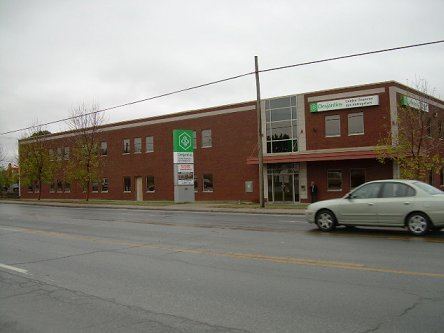Time zone EST (UTC−5) Population 46,264 (2013) Province Québec | Constituted November 3, 1975 Postal code(s) J6J, J6K Local time Friday 11:05 AM Mayor Nathalie Simon | |
 | ||
Weather -9°C, Wind W at 13 km/h, 48% Humidity | ||
Châteauguay ([ʃɑtoɡɛ], [ʃɑtoɡe]) is an off-island suburb of Montreal, in southwestern Quebec, located both on the Chateauguay River and Lac St-Louis, which is a section of the St. Lawrence River. The population of the city of Châteauguay at the 2011 Census was 45,904, and the population centre was 70,812.
Contents
- Map of ChC3A2teauguay QC Canada
- History
- Language
- Ethnicity
- Government
- Public security
- Public transit
- Utilities
- Education
- Media
- Famous people
- Twin town
- References
Map of Ch%C3%A2teauguay, QC, Canada
History
The land was first given to Charles Lemoyne by the governor of New France at the time, the Comte de Frontenac with the intention of setting up a seigneurie in the area. Afterwards the seigneurie was assumed by Zacharie Robutel de la Noue in 1706. In 1763 France relinquished its claims in Canada and Châteauguay was now under British mandate. The seigneurie was bought by Marguerite d'Youville, a founder of the Quebec religious society the Grey Nuns in 1765 and 10 years later construction began on the Church of Saint-Joachim.
Châteauguay played an important part in the colonial history of North America. With the United States having declared war on Britain in 1812, Châteauguay was seen as little more than a good vantage point to post troops to defend Montreal against an invasion. This prong of the American advance on Montreal ended with the Battle of the Châteauguay, where on October 25, 1813, Lieutenant Colonel Charles de Salaberry succeeded in halting the American force of 4,000 advancing on Montreal with only some 400 troops, mostly French-Canadian and 170 Kahnawake Mohawk warriors. The second American incursion towards Montreal was defeated shortly after at Crysler's Farm on November 11.
During the Lower Canada Rebellion, Châteauguay was the scene of a notable action involving Les Patriotes. In November 1838, members of the French-Canadian rebel group, including the leaders of the rebels were arrested: François-Maurice Lepailleur, who was later exiled to Australia, and two natives of Châteauguay, Joseph Duquet and Joseph-Narcisse Cardinal, both of whom were later hanged at the prison at Au-pied-du-courant and subsequently interred beneath a monument to les Patriotes at Notre Dame des Neiges cemetery in Montreal.
The actual village of Châteauguay was created in 1855, after the abolition of the seigneurie system in Quebec by the British colonial regime. Later on the city annexed two neighboring districts, Châteauguay-Heights (1968) and Châteauguay-Centre (1975). In 1982, with the passage of the Loi sur l'aménagement et l'urbanisme, Québec, the city became part of the Roussillon Regional County Municipality.
Language
Chateauguay has traditionally had one of the highest proportions of English speakers in the Montérégie region. As according to the 2011 census, The prominent languages primarily spoken at home by their relative share of the population are French(60%), English(30%) and Spanish(2%)
Ethnicity
Twelve different ethnic groups represent at least 1% of the population in Chateauguay. The most prominent of them according to the 2006 census and their relative share are Canadian (56%), French (29%), Irish (12%), English (10%), and Scottish (9%)
Government
The current mayor of Châteauguay is Nathalie Simon. She was initially elected on November 1, 2009 and reelected on November 3, 2013.
Public security
The Chateauguay Police have more than 130 police officers. Their duties include investigations, crime prevention and routine city patrols. The force also participates in many community efforts. The majority of these outreach programs are aimed at Chateauguay youth and focus on the prevention of drug and alcohol use which is widespread among the youth (up to 78% of the teens have used a drug on the course of last month according to a survey). The force, originally having only jurisdiction within the city limits expanded its jurisdiction over the nearby cities of Lery, Mercier, Beauharnois and Saint-Isidore between 2002 and 2007 through agreements between the municipalities.
Public transit
Public transportation is assured by CITSO (Conseil Intermunicipal de Transport du Sud-Ouest). They run two Chateauguay-Angrignon loop bus routes circulating in opposite directions. A city minibus transfers commuters from the western part of the suburb to the downtown, where the other off-peak routes pass. During rush hours, more bus routes connect the various neighbourhoods with the Angrignon bus terminal and metro station. A special express bus route connects western Chateauguay and the Chateauguay Park-and-ride with downtown Montreal, only during rush hours. A reserved lane on Highway 138 eastbound makes the connection significantly faster when the Mercier Bridge is congested. The Chateauguay public transit system also offers a Taxi-Bus service which allows those people who live outside of the normal bus routes to, by way of transfer, use a taxi funded by CITSO to drop them off at specific points in the city usually within walking distance of their residence.
Utilities
Since 1984, Châteauguay has been home to one of the largest HVDC-back-to-back stations in the world with an operating voltage of 140 kV and a maximum transmission rate of 1000 MW.
Education
The majority of the education institutions within Chateauguay are public, with the exception of College Heritage. A small list of Chateauguay schools includes:
NOVA Career Centre for adult students recently established itself in a building adjacent to Howard S. Billings. It was previously located in the school building.
During the 1980s, three English elementary schools became French due to a demographic shift:
Media
The city's local newspaper is Le Soleil (The Sun). Châteauguay Express was shut down in 2014.
